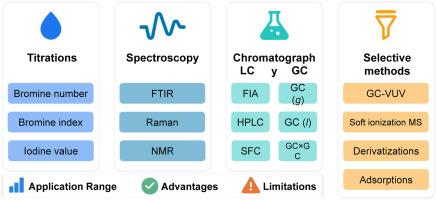塑料废油中烯烃的精确定量:分析策略和未来方向
IF 12
1区 化学
Q1 CHEMISTRY, ANALYTICAL
引用次数: 0
摘要
全球每年产生的塑料垃圾超过4亿吨,这推动了人们对热解和水热液化等化学回收工艺的兴趣。这些技术生产出富含碳氢化合物、烯烃含量高的油,提供了价格增值的机会,但也给储存稳定性和升级带来了挑战。这些复杂混合物中烯烃的精确定量仍然是一个主要的分析瓶颈。本文综述了现有的和新兴的烯烃分析方法,包括滴定法、FTIR和NMR光谱、色谱方法(1D-GC、GC × GC、HPLC)和选择性策略,如银离子络合、化学衍生化和低能电离质谱。我们强调标准化技术的局限性和先进方法的潜力,特别是GC × GC- vuv和软电离质谱,以提高选择性和灵敏度。最后,我们强调了在方法验证、标准化和异构体鉴别方面存在的差距,并提出了提高塑料衍生油中复杂基质的分析准确性、重现性和适用性的研究方向。本文章由计算机程序翻译,如有差异,请以英文原文为准。

Toward accurate olefin quantification in plastic waste oils: Analytical strategies and future directions
The global production of plastic waste exceeds 400 million tons annually, driving interest in chemical recycling processes like pyrolysis and hydrothermal liquefaction. These technologies generate hydrocarbon-rich oils with high olefin content, offering valorization opportunities but also presenting challenges for storage stability and upgrading. Accurate quantification of olefins in these complex mixtures remains a major analytical bottleneck. This review critically examines established and emerging methods for olefin analysis, including titration, FTIR and NMR spectroscopy, chromatographic approaches (1D-GC, GC × GC, HPLC), and selective strategies such as silver-ion complexation, chemical derivatization, and low-energy ionization mass spectrometry. We emphasize the limitations of standardized techniques and the potential of advanced approaches, particularly GC × GC-VUV and soft ionization MS, for enhanced selectivity and sensitivity. Finally, we highlight persistent gaps in method validation, standardization, and isomer discrimination, and propose research directions to improve analytical accuracy, reproducibility, and applicability to the complex matrices found in plastic-derived oils.
求助全文
通过发布文献求助,成功后即可免费获取论文全文。
去求助
来源期刊

Trends in Analytical Chemistry
化学-分析化学
CiteScore
20.00
自引率
4.60%
发文量
257
审稿时长
3.4 months
期刊介绍:
TrAC publishes succinct and critical overviews of recent advancements in analytical chemistry, designed to assist analytical chemists and other users of analytical techniques. These reviews offer excellent, up-to-date, and timely coverage of various topics within analytical chemistry. Encompassing areas such as analytical instrumentation, biomedical analysis, biomolecular analysis, biosensors, chemical analysis, chemometrics, clinical chemistry, drug discovery, environmental analysis and monitoring, food analysis, forensic science, laboratory automation, materials science, metabolomics, pesticide-residue analysis, pharmaceutical analysis, proteomics, surface science, and water analysis and monitoring, these critical reviews provide comprehensive insights for practitioners in the field.
 求助内容:
求助内容: 应助结果提醒方式:
应助结果提醒方式:


